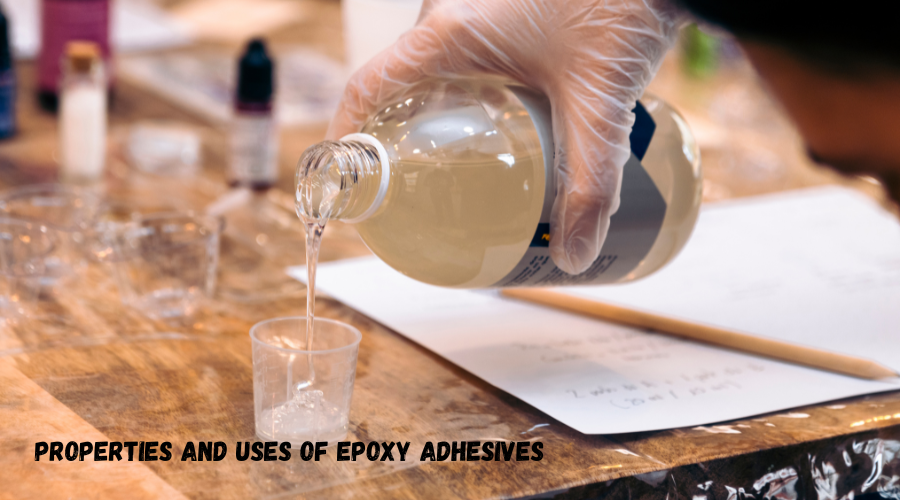


Epoxy adhesives are powerful glues that provide a permanent bond between materials. Such adhesives are used in numerous industries and residential undertakings. Learning about epoxy glues will help individuals make the correct choice of glue for their specific situation.
Epoxy adhesives are formed through a chemical reaction. A hard bond is formed by combining two parts. This is what makes epoxy dissimilar from the standard glues that dry off.
Epoxy has two principal components: resin and hardener. The resin is used as the base material. The hardener activates the chemical reaction. Once these components have been incorporated, a robust bond forms between the surfaces.
The mechanism of Epoxy bonds is known as curing. In the curing process, liquid epoxy is transformed into a solid substance. This conversion occurs as resin and hardener are mixed.
Curing time depends on temperature and the type of epoxy. Curing is accelerated in warm conditions. Cold conditions slow it down. The majority of epoxies cure fully in 24 hours.
Strength and Durability
Epoxy forms powerful bonds. These bonds are resistant to tearing, pushing, and bending. Most epoxy bonds take decades before they break.
The strength is based on cross-linked chains of molecules. These chains can be formed during the curing process, binding a fixed material.
Chemical Resistance
The majority of the epoxies are resistant to chemical treatment. Cured epoxy does not easily weaken in oil, gasoline, and cleaning products. Epoxy is applicable under extreme conditions owing to its resistance.
Temperature Handling
Normal temperatures are suitable for standard epoxies. Special epoxies that take extreme temperatures are used. Certain epoxies are used at temperatures too high, around 300°F.
Water Resistance
Cured epoxy blocks water out. This is a property that helps reduce rust and corrosion in metal parts. Waterproof epoxy bonds are a crucial component in marine applications.
Two-Part Epoxies
Two-part epoxies are available in isolated containers. The resin and hardener are blended in equal quantities by the users. It is the strongest type that needs handling with much caution.
Two-part epoxies are used in most professional applications. They can be mixed consistently to give consistent outcomes.
Single-Part Epoxies
Single-part epoxies are available for use. The curing process is triggered by heat. These epoxies are used in factories where controlled heating is available. Single-part epoxies are not often offered to home users as they require special equipment.
Fast-Setting Epoxies
The epoxies, which are fast-setting, will cure within a few minutes rather than hours. Their assistance is for small projects and fast repair tasks. The range of trade-offs is somewhat weaker than that of slow-curing ones. These epoxies are also effective for emergency repairs and projects that require quick completion.
Flexible Epoxies
Standard epoxies are cured into hard materials. Epoxies are flexible, and when they are completed, they remain somewhat bendable. This is used when there is an expansion and contraction of materials. Epoxies are flexible and, therefore, must be used with rubber, fabric, and fine metals.
Structural Epoxies
Maximum load-bearing structural epoxies will provide the highest strength. These epoxies are used in buildings, bridges, and aircraft. They are rigorously designed in accordance with engineering standards.
These epoxies are more expensive, yet they are better performers in demanding applications.
Automotive Industry
Automobile manufacturers rely on epoxy in joining body parts and interior components. Light vehicles are made using epoxy rather than welding or bolting. Weight reduction in racing cars is dependent on epoxy. Repair shops utilize epoxy to repair broken components and seal holes in metal panels.
Electronics Manufacturing
Epoxy is used on circuit boards to connect the components. The adhesive prevents the delicate components from vibrations and water. Without epoxy bonds, many electronic gadgets would not function. Manufacturers of smartphones and computers use specialized conductive epoxies.
Construction Projects
Epoxy is also used in the construction of buildings to reinforce the concrete and steel forms. Crack injections are often undertaken when repairing bridges. The bonding used prolongs the life of aging infrastructure. Epoxy coatings are used to provide durability and ease in cleaning in flooring applications.
Marine Applications
Boats and ships are in constant contact with water. Marine epoxies are resistant to corrosion and UV weathering. Repairing a fiberglass boat almost always involves the use of epoxy resins. Underwater repairs are special epoxies that cure under wet conditions.
Proper Ventilation
Epoxy, when not cured, emits fumes that are known to bring on a headache and cause breathing difficulties. Workplaces should have proper ventilation. The best ventilation is subject to outdoor work.
Skin Protection
Close contact with uncured epoxy leads to allergic reactions. Disposable gloves are used for hand protection. Accidental skin contact is avoided by wearing long sleeves.
Eye Protection
Epoxy cannot spill into the eyes because of safety glasses. Epoxy prevents the permanent harm of these chemical burns. Working with epoxy should include having emergency eye washing.
Storage and Shelf Life
Epoxy can be kept for years even when unopened. Dry storerooms and cool environments implement a long shelf life. The epoxy formulations can be damaged at very low temperatures.
The epoxy has a short life span once received. The mixed epoxy must be applied quickly before it begins to cure. Mixed epoxy that has not been used should be appropriately disposed of.
Various kinds of projects require numerous types of epoxy. Structural epoxies are needed for heavy-duty repair. Fast-fixing varieties are suitable for fast-setting ones.
Bond quality is influenced more by surface preparation than by the choice of epoxy. Rough, dirty surfaces provide more bonding strength than smooth ones.
New epoxy composites are ever better in terms of performance and safety. The environmental issues lead to the creation of more ecological options. Smart epoxies can be modified to suit their properties as needed.
Studies are being conducted to make epoxies more removable and recyclable. Such innovations will broaden the use of epoxy, as well as have a lesser environmental impact.
Epoxy adhesives are also advantageous and strong, giving long-lasting bonds. Knowledge of properties and types guides the users to choose the most suitable products. With proper safety practices, successful projects can be achieved with minimal health risks.
Epoxy adhesives can be used to bond in major construction works, as well as in simple house repairs. They are universal and powerful; therefore, they play a key role in contemporary production and repairs.
Epoxy glues are potent holding agents that are applied in numerous processes, ranging from minor
READ FULLEpoxy adhesives are powerful glues that provide a permanent bond between materials. Such adhesive
READ FULLEpoxy and acrylic adhesives are the two widely used alternatives for professional and DIY use.
READ FULL